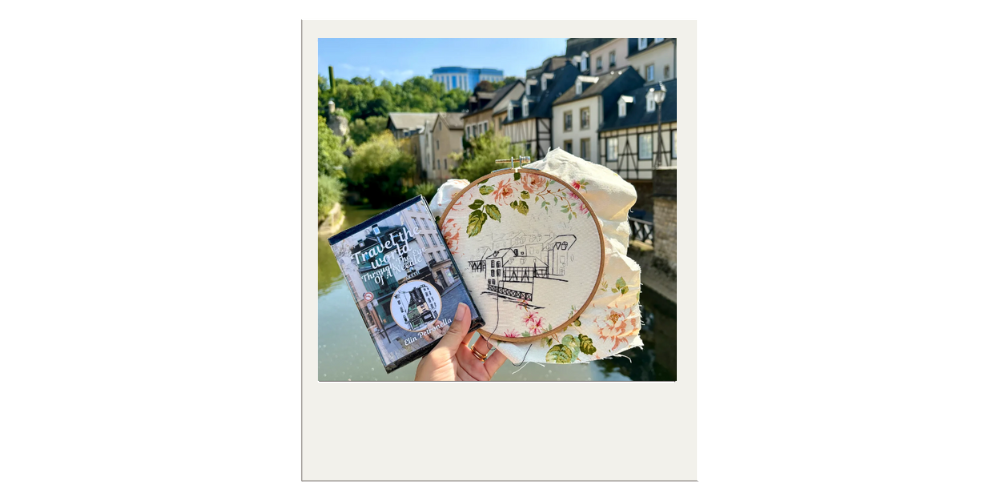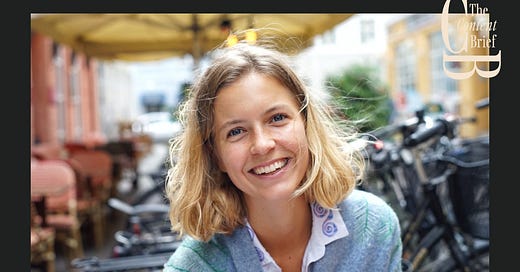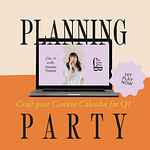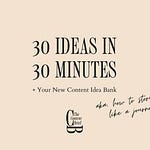Welcome to The Content Brief 💼, a fan club for making meaningful work without burning out—delivered in brief, straight to your inbox.
New here? Welcome! Subscribe free.
⏪ Last time, a workshop to create your chaos-free content plan for the next 90 days. That’s here.
**Get access to the Quarterly Content Planning Party for Q4 as a paid member of The Content Brief AND save the date Sept. 27 for a bonus live workshop on how to story mine like a journalist and find 30 content ideas in 30 minutes. Upgrade here. **
⏩ Today,
sits down for a Creator Briefing Q&A.Do you listen to your instincts when you share your work?
How do you integrate your creative pursuits into one cohesive ecosystem?
What happens when you want to pivot years of artistic creation?
These are all questions
answers in this installment of The Creator Briefing Q&A series.Elin is the creator behind
, an “art studio and creative mind open to the world,” her next step after starting her artistic career on Instagram eight years ago.You may know her from her embroidery art and the Charles and Elin Academy she co-runs with her husband. Elin also writes
, where she publishes reflective writing about the artist life and business, and just announced a forthcoming art book, “Travel the World Through the Eye of a Needle.”Elin continually sparks conversations around creativity, individuality and the pursuit of authentic living, focusing on “sharing the beauty around us and how we could all feel better with some more art.”
And here, she shows us how to enjoy the ever-evolving creative process.
As she says, "Every piece of content is necessary to unblock the next step."
The following is an excerpt from the interview. Hit play above to hear it in full.
So much of what you write about and create is centered on this idea of listening to your gut and following your creative dreams. About “life outside the box.” So take us back to the beginning. How did you first do that? What was that initial inkling of a feeling and how did you follow it?
Actually, it was all gut-led since the beginning in the sense that I never really planned it. I never started my art business going, this is an art business.
You can always think so much of: I should have done this. I should have done that. Isn't that even called the entrepreneurial syndrome where you always wish you did something sooner? And in some way, I actually think that is a quite good lesson, if you will, that just start because you're always going to wish that you did something sooner. And so I never reflected too much in the sense that I just started sharing my art, to be quite frank.
I was sitting doing embroidery at a university, I was at university in Paris, and I had people coming up asking if I could embroider their stuff. And so I was like, people want to pay for this? And then it was actually one of my clients who told me…He was from California, and he just thought it was lame that I was sending him pictures on SMS type of thing. And so he said, can't you create an Instagram account and I can just follow and you can just post whatever you did and like this, you know, that'll be easy. And I'm like, God. It's him who told me, you know, you don't have to share what you eat.
And so I really just started sharing the embroidery commissions that I got. So that is how it also really started kind of business-y from the beginning without necessarily having a plan to it more so than just sharing for the joy of it.
Writing on Substack is not your full-time focus. You’ve published two books, run an online art academy, and built a massive Instagram following. How does everything integrate? What is the throughline of your creativity now, and what’s your next big project?
I actually, just the other day, I was there with my notebook and I didn't know that you were going to ask me exactly this question. So I've been at this now for eight years. And if there's one thing that keeps coming back, it's that you constantly have to revisit the ecosystem, like how everything goes together, because it's very easy to keep adding things on.
So Instagram is one bit, but I got about 200,000 [followers] on Pinterest. We got maybe about 35,000 on YouTube. So it doesn't sound massive, but YouTube converts better into buying online courses, which is what I do in my art academy.
There's those three social media bits and then I threw in Substack in there and I started realizing that I need to kind of see how this all goes together.
I think it's very easy to get impatient where you want to just connect the dots right away when really it's very much a matter of taking small steps all the time, a little bit like creating content, right? Every little tweak is going to make each step clearer for what to do next in order to share the message with your audience and especially, or if we talk community, especially when you have a lot of people. It needs to not just be this massive bomb that comes.
And so the first step I did actually, I started two months ago. I launched the
on Substack as the first step in integrating.It was only
, which I actually created kind of like a pilot project to just see if I would be able to translate my experience of having grown up on social media into a new medium of writing. I love writing too, but I've been really specialized on visual arts. But I wanted to see if I could grow something from scratch again. It worked beautifully and I'm really excited about that.And I saw that as kind of the feedback I needed to have the courage to start integrating and to actually start bringing my previous community and business over to kind of connecting it with Substack.
It's really because I fell out of love with the other social platforms for the past four years since I had my first daughter in 2020. I've hardly posted to Instagram. So it's been kind of this open window, shopping window, without much changing. It's been like the same shopping window more or less for the past four years.
And I've been having this in the back of my mind all the time. Like, am I ever going to go back in or not? At a certain level, despite all the changes of algorithms and everything, I still kept getting impressions and I had the link to our website. So I didn't want to delete it even if I didn't post actively.
That is where the Petronella Art Magazine came from. Instagram is Petronella Art. And so I was like, OK, I will start sharing what I used to share on Instagram on Substack because I love Substack as a platform. I like to hang out there. In doing so, it gave back the energy.
What this has done really is trigger the next step, which is going to be an entire rebrand of my art business. I used to run it with my husband for the first four or five years. Having children, he started taking on other projects and I've really been the one in charge of the art business and having my kids and that's why it's been, I felt like it's been going slow. And then with Substack, I'm like, I'm ready, I'm excited.
So we're moving it over to Petronella Art. Everything's going to be Petronella Art now. So that will be the connector…
So, whatever you're creating, whatever content you're creating is never a waste as long as you keep creating.
And so now I have these traffic sources and I'm bringing them together into the art magazine. And from there, I will be connecting that to the designs as well as my online academy. So that will kind of be like the wheel, the turning wheel, the main content engine will be the art magazine and with flashes of courses, if that makes sense.
And so that is my next project really to mark this transition and to kind of celebrate this ecosystem. This evolution.
I'm actually going to create an art book because all of these things, they happen in the digital. I feel as though sometimes it's just, it's easy to get into your own bubble when we're working online…but it's actually people there…
I want to make a pocket-sized art book. It's really a way to bring kind of your digital content into a concrete physical thing. And hopefully, I can send this out to everyone who joins in. 'll be working on it this fall.
I love the idea of turning years of thoughtful work shared in one place and turning it into a wholly new thing, following what feels good to you. It should feel good to create something you’re proud of. “Content” often gets a bad, almost like it’s a dirty word. As a visual artist, how do you see content? What is the role of it in sharing your art?
So it's a brilliant question because I've received this question actually many times whenever I'm meeting or encountering other artists is always this idea of the content treadmill, right?
I don't look at it as something separate. I don't look at it as a separate thing that you need to create apart from your art. Frankly, what I tell all visual artists is that you have a massive advantage because you don't have to create anything new visually because your visual content is what you already make.
And so, for example, like I genuinely think that we have an advantage in that. I would use pictures of my art and just maybe put some quotes from snippets from my from the text I was writing…

As an artist, if we look at just the business side and the content around that, well, a business can start and end. But being an artist, it starts when you're born and it just never ends. Like, are you going to put these labels on yourself? Like, I am terracotta and sage green, or I am the, you know, sometimes I'm purple, sometimes I'm blue, sometimes I'm something else. My artwork is my brand, if you will…
Inevitably, you develop a style just as much as in writing. You develop a style if, to be frank, you stop making an effort, your style will be allowed to shine through.
Like if you genuinely just create for the love of it, you will eventually get a style. But when we stress about what's my style, what's my, you know, I need to have this, that's when I think it cramps up and it becomes kind of like, I need to create all this “content.”
But if we just do it for fun, it will eventually come. And that's when I had a lot of people saying, I can recognize if you've made an art piece before I even see it's your name. And I think, and that was when it clicked for me, when I was like, my art is my content. My art is my brand. My art actually is my entire identity.
Having done this for many years, how do you maintain your creativity? Could walk us through your creative process from when you have an idea to how you actually execute it, where you find inspiration for what you want to create, any specific habits or rituals that you have around your creativity, and how it's evolved through the years?
Well, it looks very different now after children than before children, which I imagine that you experience as well. I only have two so far, but it's vastly different. I have to say that something that I'm so grateful for in my children is how they actually emphasized and enhanced this sense that I just need to let 90% of the shit go.
You don't have time for it. And so what is left? Well, it's creating art. In the sense of before, for me, was like, I needed to have, know, the studio needed to be cleaned and I needed to have my routine and ritual and this and that and to go to the gym and the more like it was so much stuff. And then, you know, if it's not at least three hours, there's like no point in starting.
Now it's like, do I have 30 seconds? Great. And so the whole idea around like productivity also has vastly shifted. So now I don't look for ideas. I don't look for inspiration or wait for it because it's when you least look for inspiration, that's where it finds you.
When you really want it and you're like now I have one hour, I need to work, I need to get things done. I never get shit done because it's like so much pressure, because a kid will come in running here. So now I do most of my work kind of in the, in non-ideal settings because that's when suddenly like it just flows because there's no pressure, because I'm not supposed to be able to do anything anyway, right?
For example, some months ago I wrote the majority of my posts when my daughter was having naps and I was breastfeeding. Now she reduced to one nap. No! So I had to change that up, yeah? So now I write most of it when we're in the car going somewhere. Or I always carry notebooks…I have books sprinkled in every single room, in the car, because you never know if you have an idea.
The problem is when you need to find the idea afterward. That's another thing. But so I scribble notes, I draw charts and my daughter's like, great, we're drawing together. Whereas I'm like, kind of strategizing in some way, but for her, we're just sitting drawing…
And the more I work something, I can tell you, if I have to re-edit an essay more than five times, I'm never going to publish it. So it's more so that I just produce a lot. Then maybe one is like, this is good, it feels good right now. So I hit publish.
If I don't hit publish right away, I'm most likely not going to publish it at all because it means it didn't feel good. But I still have to produce it.
I don't remember who said it, but something that I embodied very early on is that every piece of content, every piece of artwork, every piece of essay, it's not going to be your best work. But it's necessary to do it in order to unblock the next step, which might be just the thing.
And so I think when we scrutinize it too much, we just kind of, and we are so obsessed with this idea of perfection. And now online we see everybody has these perfectly curated in every way and we just feel like we don't fit in, we don't belong.
And so the only thing I do is I literally put my like shields on, I do my shit, I just create, I hit publish, people resonate or they don't, that's fine. And that's how I keep it going.
Yeah, I think following what excites you and being willing to just keep showing up, I think that's the only way to move forward. I think that's the best advice you could give someone, but I'm wondering after all of your experience and through allowing yourself these evolutions and changes, if you were to meet somebody who was just starting out, who wants to create, who wants to lead a conversation of their own and bring people along with them, what would be the advice you would give them?
So I actually think it's the same thing no matter whether it's your first month or whether it's your hundredth month. It's the same going back to the basics of just creating and sharing your art…
I feel as though now, in 2024 even more so because of everything we've really gone through, this era of perfectly polished, that people are craving the raw and real more than anything. And so I think that is a liberation.
If you have this dream to just start sharing your, whether it's visual arts or whether it's written art, whatever it is that you have within you, whether it's recipes or anything. I think it's to find ways to naturally integrate whatever you're already doing. Keep doing that, but just take a photo of it or write a reflection on it. Just find ways to naturally share what it is you're already doing.
Once we try to manufacture the content rather than actually just sharing what we're already doing in a way that you would maybe with, I say friends with a little twist in the sense that many times maybe our friends and family aren't necessarily going to be the ones in our audience or in our community for our work. And so that can be a tricky one.

But still, I try to think about my community as friends in the sense of look at this, look how cool that is. Then, you know, I share it because maybe somebody else will think it's cool…I have some 500,000 [followers] across platforms and I have a lot of people, but I still kind of ignore the fact that it's a lot and still try to focus on the one person that I'm sending this to.
Because being in the digital era, especially, whether you're communicating with email or whatever platform you're using, everybody, no matter how many they are, everybody is going to receive your message on their own as if it's only you and them.
If you just do it naturally and integrate it naturally, share what you already do, don't add more to your plate. That's when you can really start seeing and you will start connecting with people who resonate with who you are and what you do in a way that can be sustainable because otherwise you'll most likely burn yourself out and you'll want to stop, you'll want to quit, you don't feel like you are able to continue, you lost the joy for it.
And I think unfortunately that's what happens to a lot of artists because it's very emotional labor.
What are you currently feeling inspired by?
So my daughters are four and one and a half, and it's still really this age where everything is very pure. Like what inspires me very much is this excitement about the small things.
I feel as though having children has made me, has allowed me to relive and re-see things that we just forget because, you know, it's part of everyday life, like how, you know, the bees fly from flower to flower and, you know, now they suddenly have these yellow things on them. Why is that? You know, just paying attention to the little details that are very easy to just forget.
So it's just really like, as I'm with them every day all the time, mean, of course, it's sometimes very overwhelming and overstimulating. Whenever we can, whenever I am able to go down to just like trying to really put myself in their shoes of being very present in the immediate environment, because that is what they are, suddenly that's when I realize, like the way the light hit that flower and then cast the shadow on the wall is really pretty.
You know, like just really paying attention and that's something that inspires me very much right now. These odd things that are not fancy at all. The smallest things, we go a lot to, it’s kind of like secondhand markets, we go a lot to that and it's just like, you know, going and observing these different objects.
I love history, architecture, historical buildings. Like imagine what these walls have seen and heard through history, you know? And it's the same about these small objects. It's the same about everything around.
Yeah, that's inspiring me to just be happy with what you have and where you're at and to actually enjoy the process, enjoy the ride because it's so easy to be stuck in ‘I want to be or I want to have’ when really everything is right here….
Inspiration tends to lead to more inspiration. It sparks an idea which sparks another idea and that is kind of like how the entire, how the thing goes. And so I see the art magazine, just art in general, my art book, as kind of like an art prompt. It's like a prompt to kind of kick this wheel off of just start getting ideas and inspiration for what can do.
And who knows what that can lead to in the future?
Only you, only you will know if you dare to.
For more from Elin Petronella, subscribe to .
If you liked this interview, you’d love being part of the club. Join The Content Brief, a fan club for solo creators after *real-life approved* content management. Then save the date for our bonus workshop Sept. 27 on how to story mine like a journalist and find 30 content ideas in 30 minutes. 🎉
Thank you for being here! I pour a lot of love into this space and I hope you can feel it. It wouldn’t be the same without YOU! 🫶



















Share this post